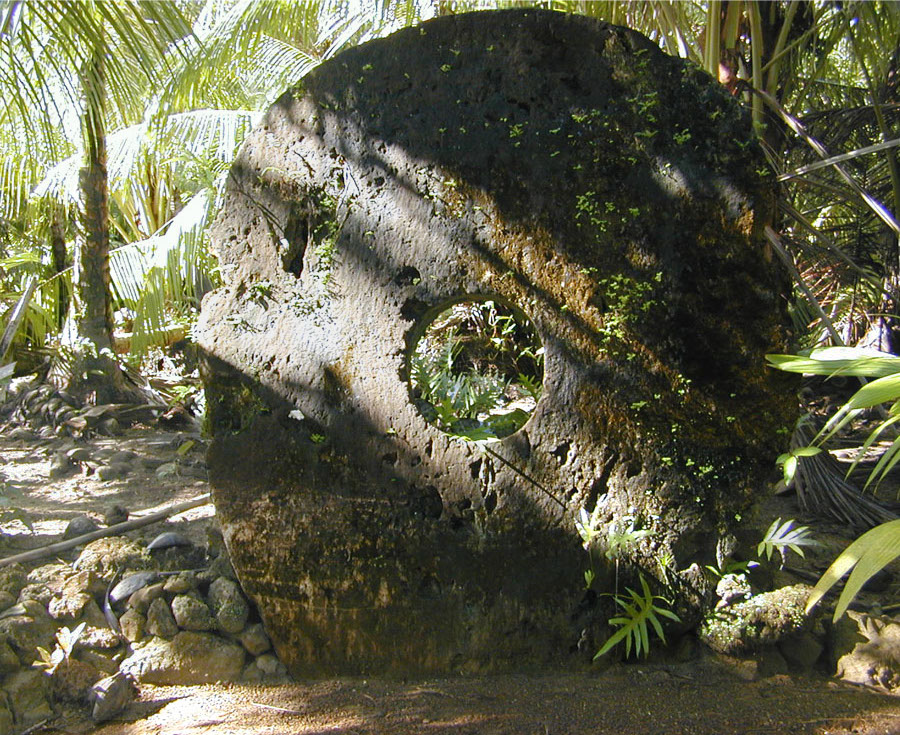Can Money Be Pure Information? Merely a Trusted Idea?
A group of pragmatic Pacific Islanders put that concept to the test centuries agoThe villagers of the island of Yap developed a unique currency system that has worked for centuries that provides insight into the way in which money is, first and foremost, a collective idea, not a thing. Yap is one of the Yap Islands, part of the Federated States of Micronesia. For many centuries, Yapese had been in the habit of traveling to another island, Palau, some hundreds of miles distant, where they milled huge limestone chunks into discs with a hole in the centre. Originally, the stones (rai) may have been ceremonial objects or ornaments of value. But at some point, a decision was made to use them as a form of currency. The currency, isolated from others, operates in some expected ways and some unexpected ones. The mix sheds light on the nature of currency itself.

in height) in the villageof Gachpar/
Eric Guinther, CC BY-SA 3.0
There is no limestone on Yap. Thus the discs, which ranged from 7cm to 3.6m (2.76 inches to nearly 12 feet) in diameter, offer scarcity, just as gold or silver does, making the currency hard to debase.
The big rai couldn’t easily be moved around. So Yap residents developed the habit of simply making oral agreements about the value and ownership of the stones, a practice which continues to this day. So far, the Yapese concept of currency is quite familiar, except that the tradition of rai currency management has been entirely oral. That works well enough, we are told, because it reflects the culture:
Families rarely move from their villages, and the tribal elders from the around 150 villages pass down information of each piece, meaning they act as a reminder of the past and help to reinforce relationships and transactions that date back to times of warriors and clans. In some cases, the stones have engravings marking battles from more than 200 years ago.
Robert Michael Poole, “The tiny island with human-sized money,” BBC, 24th February 2022
But some elements of the tradition highlight the immaterial nature of financial transactions:
One time, according to the island’s oral tradition, a work crew was bringing a giant stone coin back to Yap on a boat. And just before they got back to the island, they hit a big storm. The stone wound up on the bottom of the ocean.
The crew made it back to the island and told everybody what happened. And everybody decided that the piece of stone money was still good — even though it was on the bottom of the ocean.
Jacob Goldstein, David Kestenbaum, “The Island Of Stone Money” NPR, December10, 2010
That makes pretty clear that the tradition depends fundamentally on trust. Even the existence of the submerged stone cannot be confirmed. yet it can be used for the exchange of goods and services.
Some see this older system as prefiguring bitcoin. At ScienceAlert, Peter Dockrill writes,
… both forms of currency depend upon a public, community ledger system, that provides transparency about transactions, as well as security, and all without needing a centralised bank structure.
In bitcoin and other cryptocurrencies, that public ledger is called the blockchain: an open record of bitcoin ownership and transactions spread across multiple computers on the internet.
In rai – and the ancient culture of the Yapese islanders who used the giant stone coins – there was an equally dependable antecedent to the blockchain ledger.
Peter Dockrill, “The “Original Bitcoin” Was This Giant Stone Money on a Tiny Pacific Island, ScienceAlert 12 June 2019
Is the rai a non-digital version of bitcoin?
Archaeologist Scott Fitzpatrick and finance prof Stephen McKeon, both of the University of Oregon, have published an open access paper on the topic (2020). McKeon told Dockrill,
The things people might use bitcoin for today are obviously different, but the most striking thing about the two forms of currency is how the ledger system, in principle, performs the same function.
“As with the rai stones, information about bitcoins’ value and ownership is managed collectively,” says McKeon.
“It’s a distributed financial system as opposed to the more familiar, centralised systems involving third-party financial institutions.”
Dockrill, “The “Original Bitcoin”
In contemporary Yapese society, cash money is routine now for ordinary purchases, if only because so much of the stuff of everyday life now is not produced at home in traditional ways. Rai is used for large, important, or highly symbolic transactions. But the remarkable fact remains that the Yapese developed a viable currency system that depended on trust in the memories and intentions of others as conveyed through the oral tradition — with the stones as massive material symbols. And it has worked for centuries
You may also wish to read: Modern bitcoin’s surprising lesson about ancient scripture It turns out there’s a striking parallel between the historical record of scripture and the blockchain ledger. (Robert J. Marks)
